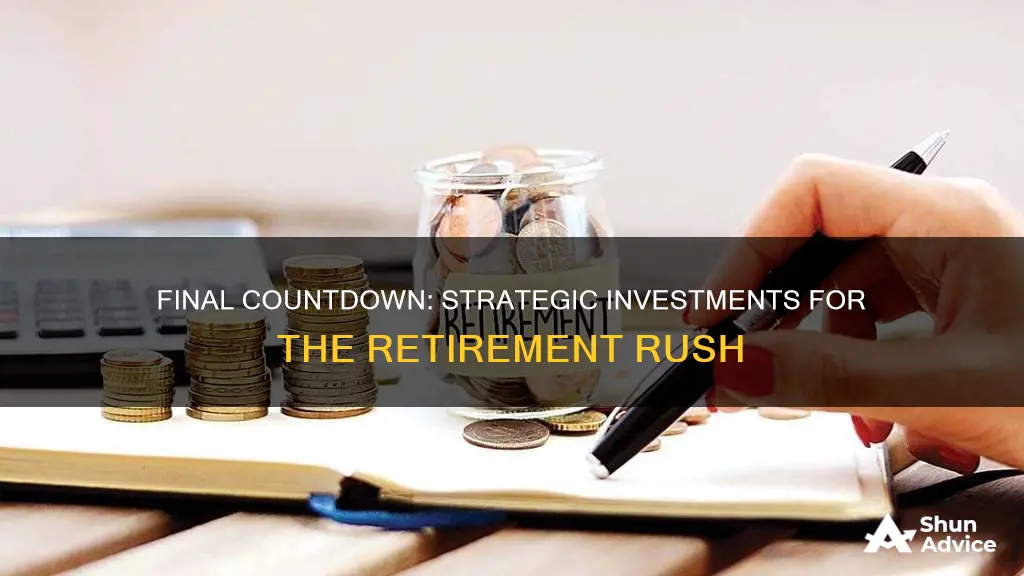
The last five years before retirement are critical. It's a good time to review your plan to make sure you're on track. It's also a test of your preparation and planning up to that point. The most important question you need to answer is: can I afford to retire?
There are several factors that can influence retirement preparedness, including how much you've saved in workplace retirement plans or IRAs, the amount of debt you have, your expected expenses in retirement, and how long your savings will need to last.
If you're approaching the last five years before retirement, you may be at a disadvantage because you have less time to benefit from compounding interest. It's natural to shift your assets toward safer investments as you get older, but you may be trading off higher returns by doing so.
- Review your savings and income sources
- Estimate your retirement spending
- Consider long-term care needs
- Review your tax situation
- Create a retirement spending plan
- Adjust your investment portfolio
What You'll Learn

Review your savings and income sources
Reviewing your savings and income sources is a critical step in retirement planning, especially in the last five years before you stop working. Here are some detailed instructions and considerations to help you navigate this process effectively:
Understand Your Savings and Investments:
- Evaluate your current savings and investments: Assess how much you have saved in retirement accounts, such as Individual Retirement Accounts (IRAs) and 401(k)s. Also, consider any other savings or investment accounts you may have.
- Adjust your investment portfolio: As you approach retirement, it's generally advisable to reduce investment risk and focus more on protecting your capital. This means shifting from growth-oriented investments (e.g., equities) to balanced and fixed-income assets, as well as bonds. However, maintaining some growth investments is essential to keep up with inflation, especially if you anticipate a longer retirement.
- Maximize registered savings plans: Take advantage of tax-free savings accounts, such as Tax-Free Saving Accounts (TFSAs), to maximize tax benefits. Also, consider utilizing Registered Retirement Savings Plans (RRSPs) to get tax deductions and refunds.
- Review and re-evaluate your investment portfolio: Periodically reassess your investment strategy and consider shifting to more conservative or lower-risk investments as retirement nears. This step is crucial to safeguarding your capital and ensuring it lasts throughout your retirement years.
Identify and Understand Your Income Sources:
- Social Security benefits: Calculate your expected monthly Social Security benefits using the Social Security Administration (SSA) website's calculator. These benefits typically form a significant portion of regular retirement income.
- Pension income: Determine if you will receive any pension income from current or former employers.
- Annuities: Include any income you will receive from annuities, such as defined-contribution plans or 401(k) plans that have been annuitized.
- Property income: Consider any income generated from real estate, royalties, or rental properties.
- Required Minimum Distributions (RMDs): Understand the age requirements and estimates of mandatory withdrawals from qualified retirement accounts, as these will impact your income during retirement.
- Other sources: Identify other potential income streams, such as inherited IRAs or other retirement accounts, Health Savings Accounts (HSAs), and income from the sale of valuable assets like art or real estate.
Analyze Your Retirement Budget and Expenses:
- Create a retirement spending plan: Estimate your expected retirement expenses by considering your current budget and making adjustments for retirement lifestyle changes. For example, expenses related to commuting may decrease, while travel costs may increase.
- Aim for minimal debt: Strive to minimize debt by the time you retire. This includes high-interest credit cards, mortgages, lines of credit, and auto loans.
- Re-evaluate lifestyle needs: Anticipate possible lifestyle changes in retirement, such as travel, part-time work, health expenses, and downsizing your home.
- Estimate retirement income: Compare your expected retirement income sources with your estimated expenses to determine if adjustments are needed.
Consult Professionals and Resources:
- Seek professional advice: Consult a financial advisor or accountant to review your savings, income sources, and retirement plan. They can provide valuable insights and guidance to ensure you are on the right track.
- Utilize online tools: Take advantage of online retirement calculators to estimate your retirement savings needs and budget. These tools can help you identify any gaps or adjustments required to meet your retirement goals.
Remember, the above steps are intended to provide a comprehensive framework for reviewing your savings and income sources. Each person's situation is unique, so tailor your approach based on your specific circumstances, goals, and priorities.
The Debt-Investment Dilemma: Navigating the Path to Financial Freedom
You may want to see also

Estimate retirement spending
Estimating your retirement spending is an important part of retirement planning. Here are some steps to help you estimate your retirement expenses and create a financial plan:
Create a Retirement Spending Plan:
Estimate your expenses during retirement by considering your lifestyle choices and daily costs. Some expenses may decrease, such as commuting costs, while others may increase, such as leisure travel. The closer you get to retirement, the more precise your spending plan can become. It is also important to try to retire with minimal debt, including credit cards, mortgages, and loans.
Understand Your Income Sources:
Identify all your potential income sources during retirement. This may include withdrawals from workplace plans (e.g., 401(k)), traditional or Roth IRAs, pension plans, Social Security benefits, rental property income, and Health Savings Accounts (HSAs). Knowing your income sources will help you determine your monthly budget and when to start withdrawals.
Estimate Retirement Spending:
Compare your estimated income with your expected monthly expenses to create a mock budget. This will help you see if your income can cover your desired lifestyle and expenses. You may also choose to live on your retirement budget for a few years before retirement to test its feasibility and save any excess funds.
Review Your Tax Situation:
Consider the tax implications of your retirement income. For example, you may benefit from converting a traditional IRA to a Roth IRA to take advantage of tax-free withdrawals. Consult a financial advisor to optimize your tax strategy and minimize liability.
Plan for Healthcare Costs:
Healthcare costs can be significant and unpredictable, so it's important to factor them into your budget. Fidelity estimates that a retired couple will need $300,000 for healthcare over their retirement. Plan for around 15% of your retirement expenses to go towards healthcare, and consider purchasing long-term care insurance to cover potential nursing care costs.
Seek Professional Advice:
Consider working with a financial advisor to fine-tune your budget and retirement income plan. They can help you create a comprehensive plan that accounts for your assets, lifestyle, and retirement goals.
Additionally, use online calculators and worksheets to estimate your retirement expenses and identify areas where you may need to adjust your spending or saving habits.
Your Investment Mix: Balancing Risk and Reward
You may want to see also

Plan for long-term care needs
Planning for long-term care needs is an important aspect of retirement planning, especially if you want to ensure that you can afford to retire in five years. Here are some key considerations and steps to help you plan for long-term care needs:
Understand Long-Term Care:
Long-term care involves a range of support services designed to assist individuals with health or personal care needs when they can no longer perform everyday activities independently. These services can be provided at home by informal caregivers, such as family members, or by formal caregivers, including nurses and therapists, who are paid for their services. Long-term care can also be provided in residential facilities, such as assisted living or nursing homes, which offer varying levels of care and support.
Assess Your Personal Risk:
Consider your health, family history, and lifestyle choices. Evaluate the likelihood of developing a serious illness or condition that may require long-term care. If your family has a history of costly, long-term illnesses, insuring your retirement assets and considering long-term care insurance are important steps.
Estimate Long-Term Care Costs:
Long-term care costs can vary widely depending on the type of care needed and the duration of care. Consider researching the costs of different care options, including in-home care, adult day care centres, and residential facilities. The median cost of care in a semiprivate nursing home room, for example, is $94,900 per year.
Protect Your Savings:
Long-term care costs can quickly deplete your retirement savings. Consider purchasing long-term care insurance to cover these expenses. This type of insurance reimburses you for care expenses when you have a chronic medical condition, disability, or disorder. Most policies will cover care given in various places, such as assisted living facilities or adult day care centres.
Evaluate Your Insurance Options:
Research long-term care insurance policies and compare quotes from different providers. Consider factors such as the amount of coverage, daily and lifetime benefit limits, cost-of-living adjustments, and elimination periods (the time you must pay out of pocket before the policy starts reimbursing you). Additionally, look into "partnership" policies, which offer benefits like cost-of-living adjustments in exchange for protecting more of your assets if you need to apply for Medicaid.
Consult a Financial Advisor:
Consider consulting a financial advisor to review your retirement plan and provide professional input on long-term care planning. They can assist you in evaluating your financial situation, estimating long-term care costs, and determining if long-term care insurance is the right choice for you.
Remember, planning for long-term care needs is an essential step in ensuring a comfortable retirement. By taking the time to understand your options and make informed decisions, you can better prepare for any potential long-term care needs that may arise during your retirement years.
Delinquent Utilities: Invest Wisely in Others' Defaults
You may want to see also

Review your tax situation
With only five years left until retirement, it's important to review your tax situation to ensure you're making the most of your savings and investments. Here are some key considerations:
Understand Tax Brackets and Income Thresholds
It's important to understand how tax brackets work and the income thresholds for each. This will help you anticipate the taxes you'll pay based on your retirement income. As you make withdrawals from your retirement accounts, stay mindful of these thresholds to avoid inadvertently bumping yourself into a higher tax bracket. Knowing your tax bracket can also help you decide between pre-tax and after-tax retirement savings accounts.
Pre-Tax vs After-Tax Retirement Savings Accounts
Retirement plans typically fall into one of two categories: pre-tax or after-tax accounts. Pre-tax retirement accounts, such as traditional IRAs and 401(k)s, allow you to defer paying taxes on your contributions and any earnings until you make withdrawals in retirement. This can lower your taxable income today, but you'll pay taxes on distributions in retirement. After-tax accounts, like Roth IRAs, are funded with money on which you've already paid taxes. Qualified distributions from these accounts are usually tax-free, which can be advantageous if you expect to be in a higher tax bracket when you retire.
Research Tax Advantages of Different Types of Income
Different types of income may be taxed differently. For example, income from selling a home that has increased in value may be partially sheltered from taxes. Capital gains from investments in property, gold, or other capital assets may also be taxed at a lower rate than ordinary income. Understanding these nuances can help you make strategic decisions about your investments and retirement savings accounts.
Start Tax Planning Early
Don't leave tax planning until the last minute. Start investigating the tax implications of various investments now so you can make informed decisions that will minimise tax implications in the future. Consult a financial professional and/or a tax professional to help you design a tax strategy that suits your circumstances.
Take Advantage of Health Savings Accounts (HSAs)
If you have access to a Health Savings Account (HSA), it's generally a good idea to maximise this tax-advantaged account. HSAs offer triple tax protection: contributions are tax-deductible, earnings grow tax-free, and qualified distributions are tax-free. Additionally, there's no time limit on using old receipts to make tax-free withdrawals for eligible medical expenses.
Retiree Investments: Unveiling the Unknown Numbers
You may want to see also

Consult a financial advisor
Consulting a financial advisor is a good idea when you have five years left until retirement. They can give you clarity on what's working in your plan and what isn't. They can also help you come up with a plan B if you're worried about anything derailing your retirement timeline.
A financial advisor can help you understand why the last five years before you retire are critical. When you're younger, time is on your side when it comes to investing for retirement. The more time you have to save and invest, the more opportunity your money has to grow. However, if you're approaching the last five years before you retire, a late start can put you at a serious disadvantage. You will have less time to benefit from compounding interest, and you may begin to shift more of your assets toward safer investments, which could mean trading off higher returns.
A financial advisor can help you review your savings and income sources. They can also help you estimate your retirement spending and long-term care needs. They can also advise on tax liability in retirement and help you come up with a five-year plan for retirement, including planning for any contingencies.
If you're within five years of retirement, it's a good time to review your plan to make sure you're on track. You'll need to answer the big question: can I afford to retire? This will depend largely on everything you've done to plan ahead. Some of the most important factors that can influence retirement preparedness include:
- What you've saved in workplace retirement plans or IRAs
- The amount of debt you have, apart from your mortgage
- Your expected expenses in retirement, based on your preferred lifestyle
- How long your savings will need to last, based on your age at retirement
Morningstar's Guide for Senior Investors
You may want to see also
Frequently asked questions
If you're not financially prepared for retirement, you may need to delay your retirement or modify your planned retirement lifestyle. You could also consider making changes to reduce your annual expenses or increasing your retirement account contributions.
Estimating your retirement spending involves creating a mock budget that outlines your expected monthly income and expenses. You can use your current budget as a starting point, eliminating expenses that will no longer apply and adding or increasing expenses that will be relevant during retirement.
As you get closer to retirement, it's generally recommended to adjust your investment portfolio to take on less risk and protect your assets. This involves shifting from growth-focused investments, such as equities, to more conservative investments, such as balanced and fixed-income assets, bonds, and mutual funds.
Besides financial planning, it's important to consider non-financial aspects that can contribute to a happy retirement. This includes staying busy and healthy, fostering relationships, finding meaningful activities or part-time work, and maintaining social interaction and self-esteem.







